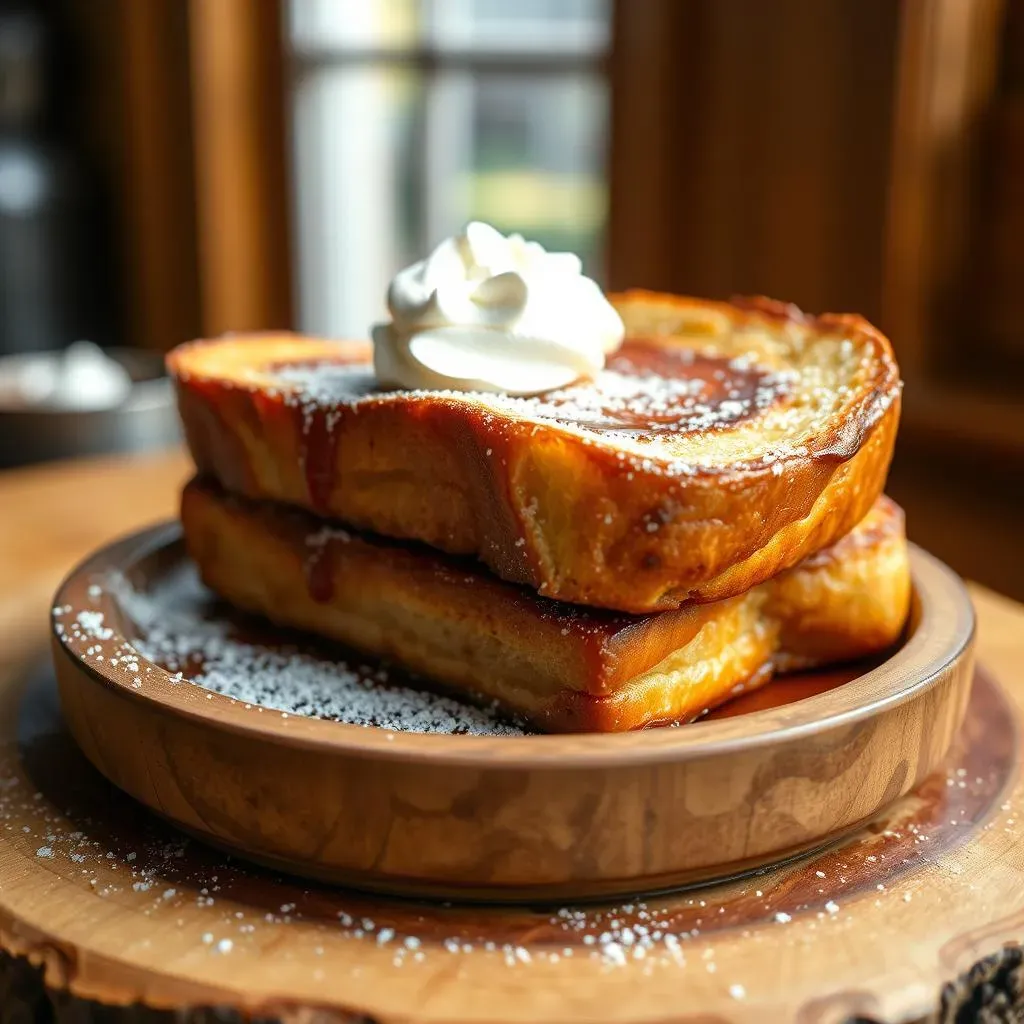Table of Contents
Are you tired of throwing away leftover sourdough bread? Do you crave a delicious and easy weekend breakfast that’s both satisfying and impressive? Then prepare yourself for a culinary adventure! This article is your ultimate guide to mastering the art of French toast with sourdough bread recipe. We’ll explore why sourdough bread is the surprisingly perfect choice for this classic breakfast dish, revealing its unique qualities that elevate the experience beyond the ordinary. We'll then dive into a step-by-step, foolproof recipe for making incredibly delicious French toast, complete with expert tips and tricks to achieve that perfect golden-brown crust and wonderfully soft interior. Beyond the basics, we'll unlock the potential for creativity with exciting variations on the classic french toast with sourdough bread recipe, from sweet additions to savory twists. Get ready to transform your stale sourdough into a breakfast sensation that will leave your taste buds singing! Let's get started on your journey to French toast perfection.
Why Sourdough is Perfect for French Toast

Why Sourdough is Perfect for French Toast
The Unique Texture of Sourdough
Sourdough bread, with its slightly tangy flavor and open crumb structure, offers a textural advantage over other bread types for French toast. The irregular holes within the sourdough allow the custard mixture to penetrate deeply, resulting in a beautifully moist and evenly cooked interior. Unlike softer breads that can become mushy, sourdough maintains a pleasant chewiness even after soaking, preventing that dreaded soggy center. This unique texture is a key ingredient to a superior French toast experience. For more on making great sourdough, check out our French sourdough bread recipe.
Think of it like this: Imagine trying to soak a sponge versus a dense brick. The sponge (like sourdough) readily absorbs liquid, while the brick (like a dense white bread) resists. That's the magic of sourdough's open crumb!
Bread Type | Texture in French Toast |
|---|---|
Sourdough | Chewy, moist, holds shape |
White Bread | Often soggy, can fall apart |
Brioche | Soft, but can become overly saturated |
Stale Sourdough? No Problem!
Another fantastic reason to use sourdough is that slightly stale bread actually works *better*! The slightly drier texture of day-old (or even a few days old!) sourdough absorbs the custard beautifully without becoming overly soggy. This means you can use up leftover bread, reducing food waste and creating a delicious breakfast. If you're looking to make the most of your sourdough, a sourdough discard recipe might also be helpful.
Many recipes call for day-old bread specifically for this reason; sourdough is no exception. In fact, using slightly stale bread can often result in a crispier exterior and a more evenly cooked interior, making it a win-win situation! This is because the moisture content is slightly lower, allowing for better absorption and crisping.
- Reduces food waste
- Creates a crispier exterior
- Better custard absorption
The Best French Toast with Sourdough Bread Recipe

The Best French Toast with Sourdough Bread Recipe
The Custard: Your Flavor Foundation
Let's talk custard! This isn't just some milk and egg mixture; it's the heart and soul of your French toast. We're aiming for a creamy, flavorful base that perfectly complements the tangy sourdough. I recommend using whole milk for richness, but feel free to experiment with alternatives like almond milk or oat milk if you have dietary restrictions. For a touch of sweetness, add a tablespoon or two of honey or maple syrup. A dash of vanilla extract and a sprinkle of cinnamon will enhance the warmth and depth of flavor. Don't forget a pinch of salt—it might sound strange, but it truly balances the sweetness and brings out all the other flavors. For more creative ideas using your sourdough starter, check out our sourdough discard recipes.
The key here is to whisk everything together until it's smooth and frothy. This incorporates air, giving your French toast a lighter texture. Think of it like whipping egg whites—the more air you incorporate, the fluffier the result. A good whisk is essential here. An immersion blender will also work.
- Whole milk (or alternative)
- 2 large eggs
- 1 tbsp honey or maple syrup
- 1 tsp vanilla extract
- 1/4 tsp ground cinnamon
- Pinch of salt
Cooking Your Sourdough French Toast to Perfection
Now for the fun part: cooking! Heat a non-stick skillet or griddle over medium heat. Add a knob of butter (or your preferred cooking oil) and let it melt before adding your sourdough slices. Dip each slice into the custard mixture, ensuring both sides are fully coated. Let them soak for a minute or two to absorb the flavor, but not so long that they become completely saturated. Now, this is where the magic happens; you want to cook them gently to get that golden brown color and perfectly cooked interior. Cook for 2-3 minutes per side, or until golden brown and cooked through. If your bread is particularly thick, you may need to increase cooking time slightly. For more sourdough-based breakfast ideas, check out our amazing sourdough French toast recipes.
Don't overcrowd the pan! Work in batches if necessary to ensure even cooking. Once cooked, serve immediately with your favorite toppings—maple syrup, fresh berries, whipped cream—the possibilities are endless! Remember, practice makes perfect. Don't be discouraged if your first attempt isn't flawless. Keep experimenting, and you'll soon be making restaurant-quality sourdough French toast at home.
Step | Instructions |
|---|---|
1 | Prepare the custard mixture |
2 | Heat the skillet/griddle |
3 | Soak the sourdough slices |
4 | Cook for 2-3 minutes per side |
5 | Serve immediately |
Tips and Tricks for Perfect Sourdough French Toast

Tips and Tricks for Perfect Sourdough French Toast
Bread Selection and Preparation
Choosing the right sourdough is half the battle! A slightly tangy sourdough with an open crumb structure is ideal. Avoid overly dense or overly crusty loaves. Day-old bread is perfect; it absorbs the custard beautifully without becoming soggy. If your sourdough is a bit too fresh, you can lightly toast the slices before dipping to help them absorb the custard better. For more tips on choosing the perfect sourdough, check out our guide on sourdough vs. French bread.
Before you begin, slice your sourdough to a consistent thickness – about ¾ inch is ideal. Uniform thickness ensures even cooking and prevents some slices from becoming overcooked while others remain underdone. A sharp knife will give you clean, even cuts. If you're using a particularly crusty loaf, you might consider gently trimming the crusts for a softer texture, though many people enjoy the added crunch.
- Use day-old sourdough for best results
- Slice bread to a consistent thickness (¾ inch)
- Consider trimming crusts (optional)
Custard Consistency and Soaking Time
The custard is key to moist, flavorful French toast. Aim for a custard that's rich and creamy, but not too thin. If your custard seems too thin, you can whisk in a tablespoon or two of flour to thicken it slightly. Conversely, if it's too thick, add a splash more milk to adjust the consistency. A good rule of thumb is that your custard should coat the back of a spoon smoothly. For more advanced sourdough baking techniques, see our 8-hour sourdough bread guide.
Don't rush the soaking process! Allow the sourdough slices to soak in the custard for at least 2-3 minutes per side, gently pressing down to ensure they're fully saturated. This allows the bread to absorb the flavors of the custard and prevents it from becoming dry. Over-soaking can lead to mushy French toast, so keep an eye on the slices and don't let them sit in the custard for too long.
Custard Consistency | Action |
|---|---|
Too thin | Add 1-2 tbsp flour |
Too thick | Add a splash of milk |
Cooking Techniques for Golden Perfection
Cooking your French toast over medium heat is crucial for achieving that perfect golden-brown crust without burning the inside. If the pan is too hot, the outside will burn before the inside is cooked through. If it's too cool, your French toast will be soggy. Use a non-stick pan or griddle to prevent sticking and ensure even cooking. A little butter or oil will add flavor and prevent sticking further. For a deeper dive into sourdough baking, consult our French sourdough recipe.
Don't overcrowd the pan! Cooking in batches ensures even browning and prevents the French toast from steaming instead of frying. Once flipped, reduce the heat slightly to ensure the inside cooks fully without burning the outside. A few minutes per side should be sufficient, but adjust the cooking time based on the thickness of your slices. A quick peek with a spatula will help determine doneness.
Delicious Variations on French Toast with Sourdough Bread Recipe

Delicious Variations on French Toast with Sourdough Bread Recipe
Sweet & Savory Adventures
Let's face it, plain French toast is delicious, but sometimes you crave a little something extra! The beauty of sourdough French toast is its versatility. The slightly tangy flavor of the bread acts as a fantastic base for both sweet and savory toppings and additions to the custard itself. Think of it as a blank canvas waiting for your culinary masterpiece. Want to explore more sourdough recipes? Check out our sourdough discard recipes for inspiration.
For a sweet twist, consider adding some seasonal fruit to your custard mixture before dipping the bread. Imagine the warmth of cinnamon and the sweetness of apples in the fall, or the bright zest of oranges and berries in the summer. A drizzle of honey or maple syrup after cooking enhances the sweetness even further. You could also add chocolate chips to the custard for a decadent treat. For another delicious twist on breakfast, try our French toast bake recipe.
- Add fruit to the custard (apples, berries, bananas)
- Incorporate spices (pumpkin pie spice, cardamom)
- Drizzle with honey, maple syrup, or chocolate sauce
- Top with whipped cream, nuts, or chocolate shavings
Savory Sensations
But wait, there's more! Sourdough French toast isn't limited to sweet treats. Embrace your adventurous side and explore the savory possibilities. A simple sprinkle of herbs like rosemary or thyme can transform your French toast into a sophisticated brunch item. A savory custard, featuring cheese and herbs, paired with a fried egg on top creates a hearty and flavorful breakfast option. For even more savory sourdough ideas, check out our article on sourdough vs. French bread.
Imagine the possibilities! A sprinkle of parmesan cheese and a drizzle of balsamic glaze could elevate your French toast to new heights. Consider adding crumbled bacon or sausage for a heartier meal. The combination of the tangy sourdough, savory additions, and the creamy custard creates a truly unique and satisfying breakfast experience. Don't be afraid to experiment and create your own signature savory sourdough French toast creation. This is your chance to get creative and impress your friends and family with a truly unique breakfast.
Savory Addition | Flavor Profile |
|---|---|
Herbs (rosemary, thyme) | Earthy, aromatic |
Cheese (cheddar, parmesan) | Sharp, savory |
Bacon or sausage | Salty, smoky |
